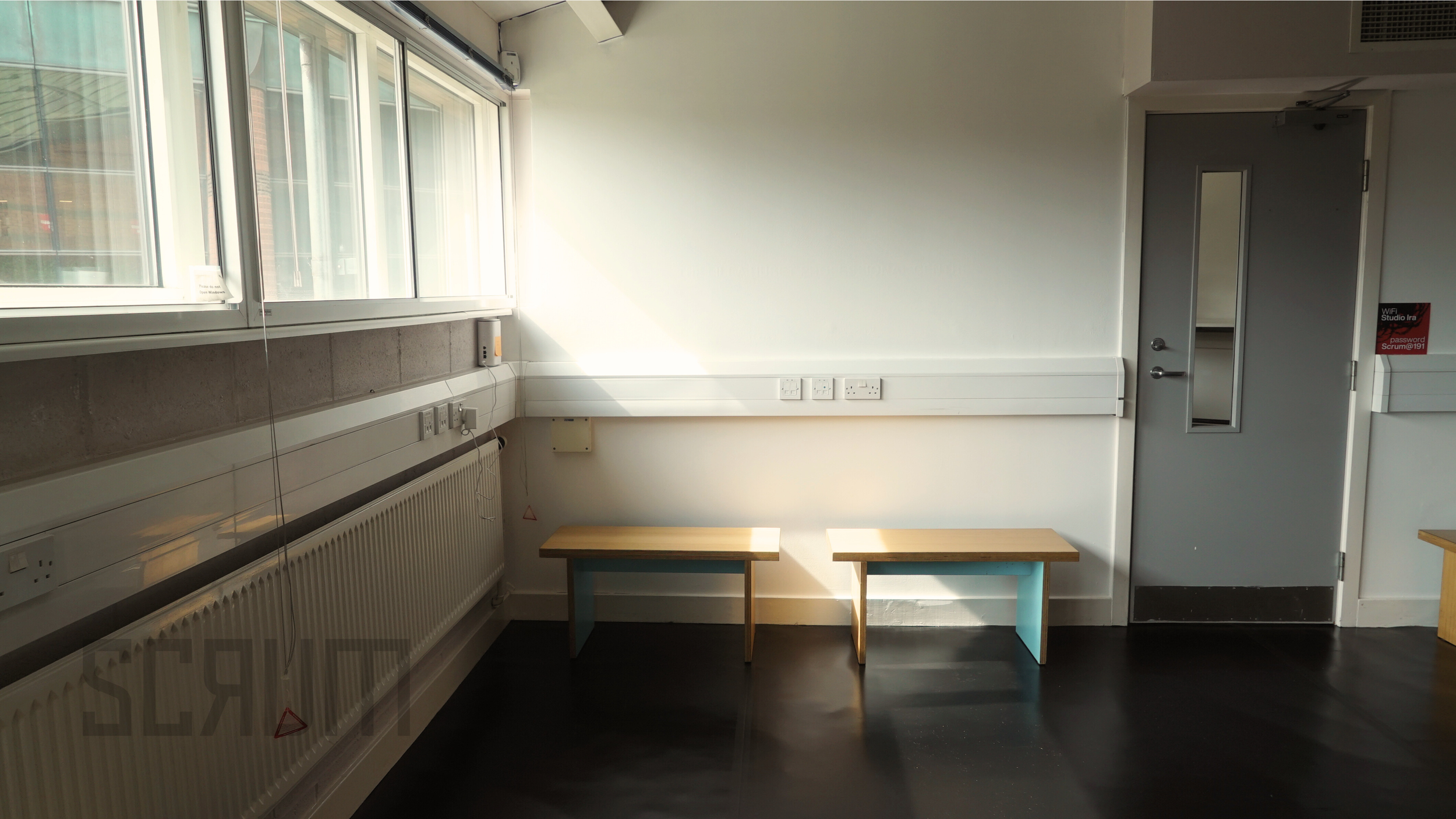





Our rehearsal studios
-

Studio Sarah
7m x 14m step-free studio with exclusive facilities
Studio Sarah is a self-contained unit, spanning most of the ground floor. Wheelchair accessible, with exclusive kitchen, wheelchair accessible toilets, on-site parking and secure overnight storage.
There is also a quiet and a breakout room, both of which can double as production offices.
Equipped with an upright piano, benches and WiFi. The studio has vinyl flooring. Plenty of natural light.
Commercial: £300 day/£200 half day
Subsidised: £200 day/£120 half day
-

Studio Federico
5.5m x 14m
Studio Federico is a versatile, modular rehearsal space. Its pull-out room divider gives users the option to split the studio across its centre.
This bright studio boasts large windows and two skylights. Access to shared kitchen, breakout spaces and nearby toilets. Contact us in advance for on-site parkings spaces. Secure overnight storage.
Equipped with benches, WiFi and an exclusive sink. Black dance floor. Plenty of natural light.
Commercial: £250 day/£150 half day
Subsidised: £180 day/£100 half day
-

Studio Ira
7m x 10m
Studio Ira is a beautiful rehearsal space, with views over leafy West London.
Great acoustics and lighting. Although we don't play favourites, this is the studio most used by the company. Access to shared kitchen, breakout spaces and nearby toilets. Contact us in advance for on-site parkings spaces. Secure overnight storage.
Equipped with benches and WiFi. Black dance floor. Plenty of natural light.
Commercial: £250 day/£150 half day
Subsidised: £180 day/£100 half day
The spaces at SCRUM Studios exist with the aim of creating a diverse artistic community. Subsidised prices are offered for individual artists, small groups, small charities and small theatre companies.

Studio Federico

Studio Federico

Studio Federico

Studio Federico

Studio Federico

Studio Sarah

Studio Sarah - Breakout Room

Studio Sarah - Kitchen

Studio Sarah - Quiet Room

Studio Sarah - Breakout Space

Studio Ira

Studio Ira

Studio Ira

Studio Ira
Our Studio Heroes
Our rehearsal studios Federico, Ira and Sarah are named in honour of people we consider heroes of theatre history: Federico García Lorca, Ira Aldridge and Sarah Bernhardt. Each studio features a mural of the hero its named after, painted by William Dawkins. You can read about their lives in the dropdown menus below.
Federico García Lorca
Iconoclast poet, playwright & director
-
(1898-1936)
Federico García Lorca saved politics not for his poetry but for his plays. And where he produced these plays mattered almost as much as what he put in them. In 1931, Lorca was appointed director of a government-sponsored student touring theatre company, La Barraca. His mission: ‘to get ordinary working people into the theatre.’ In a van with a portable theatre, the company travelled dusty country roads to spectators all over rural Spain, many of whom had never before attended a dramatic performance. Lorca penned his greatest plays during this time, including Blood Wedding (1933), Yerma (1934), and The House of Bernarda Alba (1936).
Although Lorca could never address his homosexuality directly in his plays, he wrote tragic heroines whose struggles with marginalization, surveillance, tyranny, and frustrated love reflected the experiences of women and queer people alike within conservative Spanish society.
Lorca was murdered by fascist forces one month into the Spanish Civil War. He is remembered as one of Spain’s greatest writers and remains a potent symbol of the 140,000 people who were disappeared during and after the Civil War, many of them also LGBTQIA+ and courageous critics of authoritarianism.
Ira Aldridge
Trailblazing actor, playwright & activist
-
(1807-1867)
The African Grove Theatre (1821-23) was a Black-founded theatre company operating in downtown Manhattan. It was there that Ira Aldridge learnt both his craft, and that if he wanted to achieve the level of success he yearned for, he would have to leave the pre-Civil War United States. So Aldridge worked his passage as a steward on a ship sailing to Britain, where slavery had been abolished since 1807.
In 1833, at the Theatre Royal, Covent Garden, Aldridge became the first Black man to play Othello at a first-rate London theatre. He also excelled playing Macbeth, King Lear, Shylock, Titus Andronicus, and Richard III, and is credited with introducing a more naturalistic acting style to Europe. He was celebrated for addressing audiences at the end of his performances with powerful speeches on the abolition of slavery.
When the British press orchestrated an attack on him for marrying Margaret Gill, a white woman, Aldridge left Britain to tour Continental Europe and Russia. There he performed to packed houses and was showered with accolades including the Gold Medal for Arts and Sciences, conferred on him by the King of Prussia, the title of Chevalier Aldridge, Knight of Saxony, as well as the greatest reviews of his career.
When he died aged 60 whilst on tour in the Polish city of Łódź, he was given a state funeral.
Sarah Bernhardt
‘The greatest actress in the world’
-
(1844-1923)
One night, at the climax of a production of La Tosca, the woman celebrated as ‘the greatest actress in the world’ threw herself from the parapet of Sant’Angelo prison, but there was no mattress beneath to break her fall. Sarah Bernhardt’s right knee never recovered. For the next nine years Bernhardt lived and worked with chronic pain until, by 1915, it became so agonizing that she resolved to have the leg amputated. Reassuring admirers that it wouldn’t halt her career, she insisted, ‘In case of necessity, I shall have myself strapped to the furniture.’ And she did.
Dissatisfied with the prosthetic technology of the time, Bernhardt devised several alternatives, most notably a sumptuous white sedan chair which stagehands would use to carry her on and off the stage. Each theatrical production, film, and tour she would then embark on, including a tour of the front line to entertain the French troops, placed Bernhardt’s access requirements and autonomy at its centre.



